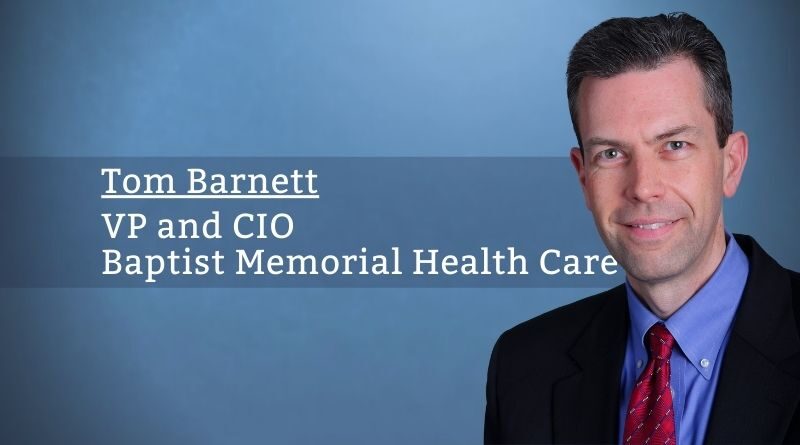A Transformation by Any Other Name Is Digitally the Same
How to Achieve ‘Easy Speed’ in Health Care with Your Digital Renovation Initiatives
By Tom Barnett, VP and CIO, Baptist Memorial Health Care
There is a dizzying amount of technology coming at us faster and faster. It can seem like Moore’s Law is powered with atomic power some days.
I had a conversation with a health care CEO in California not too long ago. We were discussing his approach to transformation and digital technologies in health care.
“There is always cool or innovative technology coming at you – and it’s not always something you can do anything with at the moment – but I need to know about it,” this executive said. “But if I’m not careful, I will spend too much time gazing at what’s new or possible without delivering any results.”
This executive went on to say that what you really need in those moments is a way to get your bearings and find “true north” as you navigate the often choppy waters of digital transformation. Conversational Artificial Intelligence (AI)? Sure. Robotic process automation (RPA)? You bet. Deep data mining and analytics? Absolutely! Where should we start however?
Then this executive offered an insight into his “true north.”
He said, “I always step back and ask myself ‘what problem am I trying to solve?’”
I have come to see the wisdom of his approach as it pertains to leading a technology function in health care. It can be very easy to fall into the trap of becoming enamored with an exciting new tech object and then trying to find somewhere in the health system to make it work. When I am holding a new, shiny, titanium Bluetooth hammer, it seems everything does start to look like a nail.
The improvement potential in health care is huge. While we have, as an industry, largely moved to electronic medical records (EMR) during the past ten years, much of what we do can still be mired in old processes, dated mindsets, and very manual ways of doing things. It is ripe for transformation, particularly in back-office processes.
I always try to begin each initiative with that sage executive’s question, “What problem am I trying to solve?”
1. To Whom Are You Listening?
Where do you find those problems? How do you know where they are? Do you know which ones are the right problems?
Don’t assume you know what the problems are that need solving. Ask and then listen. Physician committees, nursing councils, and patient focus groups are a goldmine of ideas for things that need to be fixed or issues that may be irritating to the very people we rely upon to make health care function smoothly.
How do you get that feedback? How do you prioritize those ideas and score them fairly to know what problems will have the biggest impact when solved? What’s the signal and what’s the noise? This is where solid governance can’t be emphasized enough. You need these forums not only to make decisions but to hear firsthand from the very people who live this business each and every day. Talk to them and they will guide you exactly where to focus your efforts.
2. Process Improvement
In some industries, these are known as industrial engineers or LEAN practitioners. In health care, this can also be known as Value Stream Mapping. Having a group or team that can focus on small, rapid process improvements and streamlining steps and flows is extremely important. It’s so important that it can easily be up to 80% of the work involved in solving the “true north” problem.
I have often compared the process redesign work to preparing a wall for painting. The seemingly endless sanding, filling nail holes, and spackling cracks is the work that will make that designer digital paint really look its best. The health care and its “right now” mission doesn’t always lend itself to stepping back and looking at better ways to do things.
3. Digital Innovation Team
And now we talk about the technology – not the “what,” but “who.”
I recommend that every organization find (and fund) a really sharp group of a few folks who are not only smart but intensely curious. They love to integrate and try any technology and dive in to see how things really work and how different technologies can fit together—carefully kicking the tires on each promising technology for strengths and weaknesses of each. This is the group that is constantly exploring and trying emerging technology. They are seeing new product releases and always talking to peers. They have experimented with AI, are fluent with virtual reality (VR), and are way beyond familiar with the inner workings of most smartphones. These are the team members who can see possibilities, can reach into their mental memory banks, and know which technology they have seen that might be the best fit.
Technology can be a fantastic tool to accelerate almost anything. If you accelerate a poor workflow process, it’s still a poor process, only faster, and sometimes that might be okay. However, really cleaning up the process and the technology can deliver exponential results.
An author I read recently used a great term. He talked about the ability to make complex things seem easy to do. He called it “Easy Speed.” Easy Speed is an art form to a certain extent. Making the complex processes easy for people to accomplish is, in essence, digital transformation.
So this is how I would summarize digital transformation. Find the right problem to solve, simplify the process, streamline the workflow, and choose the right technology to accelerate the whole solution.
Process is always upstream from technology, and any digital transformation effort should take that into consideration.
Keeping my eye on true north.



